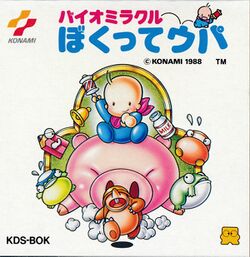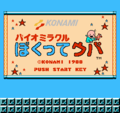(Guide complete) |
(migrate) |
||
| (One intermediate revision by one other user not shown) | |||
| Line 1: | Line 1: | ||
{{Header Nav|game=Bio Miracle Bokutte Upa | {{Header Nav|game=Bio Miracle Bokutte Upa}} | ||
{{ | {{Game | ||
|completion=4 | |||
|image=Bio Miracle Bokutte Upa FDS box.jpg | |||
|title=Bio Miracle Bokutte Upa | |title=Bio Miracle Bokutte Upa | ||
|developer=[[Konami]] | |developer=[[Konami]] | ||
|publisher=[[Konami]] | |publisher=[[Konami]] | ||
| | |year=1988 | ||
|genre | |systems={{syslist|fds|nes|mobile|wii}} | ||
|genre=[[Action]] | |||
|players=1 | |players=1 | ||
|modes=[[Single player]], [[Multiplayer]] | |||
}} | }} | ||
{{nihongo|'''Bio Miracle Bokutte Upa'''||バイオミラクルぼくってウパ}} ia an {{c|action}} game developed by [[Konami]]. It was originally published for the [[Famicom Disk System]] in [[1988]]. Five years later, it was re-released in cartridge format for the [[Famicom]]. The game's main character is a baby called Upa. "Bokutte" is a Japanese method of self-declaration. In [[2006]], a conversion was released for Japanese mobile phones, and in [[2008]], the game was made available through Nintendo's [[Virtual Console]] service. | |||
{{nihongo|'''Bio Miracle Bokutte Upa'''||バイオミラクルぼくってウパ}} ia an {{c|action}} game developed by [[Konami]]. | |||
Baby Upa must use a rattle to attack his enemies. When injured by the rattle, the enemy inflates and floats away. These inflated enemies can then be used as temporary floating platforms to climb to higher places or they can also be used as weapons if pushed in any direction. If used as a platform, Upa must not stay on top for too long or otherwise it will explode. But if used as a weapon, Upa has to pounce or use his rattle on the inflated enemy to cause it to careen. The enemy will then ricochet off objects and potentially cause damage to both the protagonist and other enemies if it comes in contact with them. | Baby Upa must use a rattle to attack his enemies. When injured by the rattle, the enemy inflates and floats away. These inflated enemies can then be used as temporary floating platforms to climb to higher places or they can also be used as weapons if pushed in any direction. If used as a platform, Upa must not stay on top for too long or otherwise it will explode. But if used as a weapon, Upa has to pounce or use his rattle on the inflated enemy to cause it to careen. The enemy will then ricochet off objects and potentially cause damage to both the protagonist and other enemies if it comes in contact with them. | ||
The game uses a health meter to monitor the player's remaining life which can be replenished by obtaining bottles of milk scattered throughout the levels. A heart icon can also be obtained, increasing the maximum health by one unit for the duration of the current world. | The game uses a health meter to monitor the player's remaining life which can be replenished by obtaining bottles of milk scattered throughout the levels. A heart icon can also be obtained, increasing the maximum health by one unit for the duration of the current world. Most items, including the milk bottles and hearts, can be collected by striking special blocks which feature Upa's face. Other items include: Apples, which increase the player's score; hourglasses, which temporarily freeze enemies in place; bells, which give Upa temporary invincibility and the ability to run; and scorpion blocks, which kills all enemies on screen when it is pushed off a platform and hits the ground. | ||
<gallery> | <gallery> | ||
File:Bio Miracle Bokutte Upa FDS title.png|Title screen | |||
File:Bio Miracle Bokutte Upa FC box.jpg|Famicom box | |||
</gallery> | </gallery> | ||
Latest revision as of 21:33, 8 May 2022

| Bio Miracle Bokutte Upa | |
|---|---|
| Developer(s) | Konami |
| Publisher(s) | Konami |
| Year released | 1988 |
| System(s) | Family Computer Disk System, NES, Mobile, Wii |
| Genre(s) | Action |
|---|---|
| Players | 1 |
| Modes | Single player, Multiplayer |
Bio Miracle Bokutte Upa ( バイオミラクルぼくってウパ?) ia an action game developed by Konami. It was originally published for the Famicom Disk System in 1988. Five years later, it was re-released in cartridge format for the Famicom. The game's main character is a baby called Upa. "Bokutte" is a Japanese method of self-declaration. In 2006, a conversion was released for Japanese mobile phones, and in 2008, the game was made available through Nintendo's Virtual Console service.
Baby Upa must use a rattle to attack his enemies. When injured by the rattle, the enemy inflates and floats away. These inflated enemies can then be used as temporary floating platforms to climb to higher places or they can also be used as weapons if pushed in any direction. If used as a platform, Upa must not stay on top for too long or otherwise it will explode. But if used as a weapon, Upa has to pounce or use his rattle on the inflated enemy to cause it to careen. The enemy will then ricochet off objects and potentially cause damage to both the protagonist and other enemies if it comes in contact with them.
The game uses a health meter to monitor the player's remaining life which can be replenished by obtaining bottles of milk scattered throughout the levels. A heart icon can also be obtained, increasing the maximum health by one unit for the duration of the current world. Most items, including the milk bottles and hearts, can be collected by striking special blocks which feature Upa's face. Other items include: Apples, which increase the player's score; hourglasses, which temporarily freeze enemies in place; bells, which give Upa temporary invincibility and the ability to run; and scorpion blocks, which kills all enemies on screen when it is pushed off a platform and hits the ground.
-
Title screen
-
Famicom box
Story[edit]
Upa is the prince of a magical kingdom and the most recent in a line of brave fighters. One day, though, he broke an urn containing the spirit of Zai, an incredibly evil goatish demon who takes the life force of the kingdom's adults and kidnaps all the babies - except for Upa, who is given a magical rattle by a fairy who was trapped in the urn along with Zai. And so, in order to save his kingdom, Upa crawls into action...
Cartridge version[edit]
In 1993, the game was released as a cartridge for the Famicom. While it is practically identical to the FDS version of the game, there are a few differences. The most notable difference is in the game's sound. The Family Computer Disk System contained an extra audio channel not available in the Family Computer/NES games. To compensate for the missing audio channel, the music in the Famicom cartridge version had to be remixed. A difficulty option was also added. Now, the player is given a choice between an "Easy" mode (where enemy damage is reduced and the player starts with more lives) and a "Normal" mode, which is the same difficulty as the original FDS version. Finally, among the smallest of alterations to the game is the title screen, which no longer contains a large image of Upa when it is first displayed.

